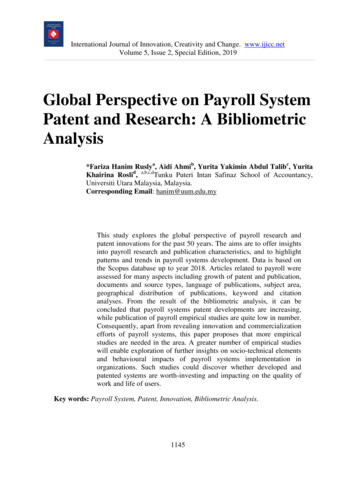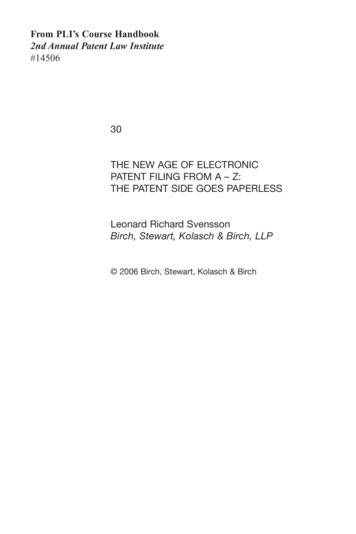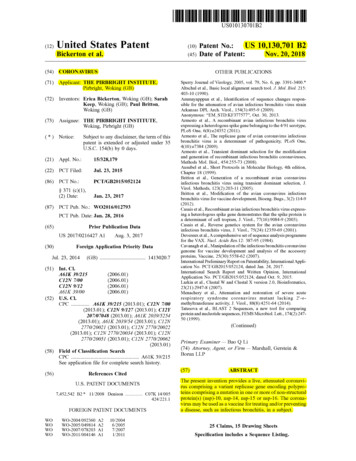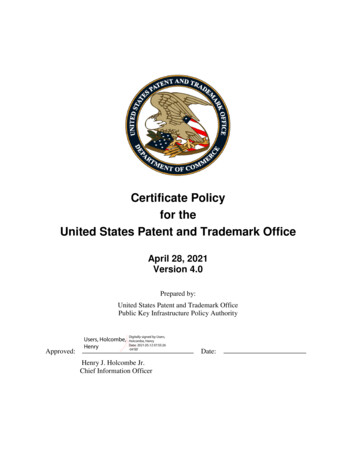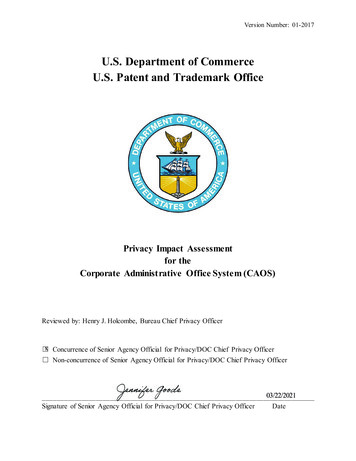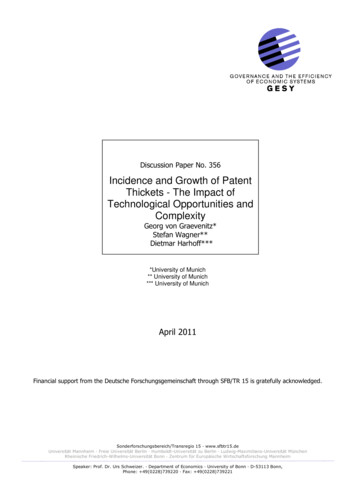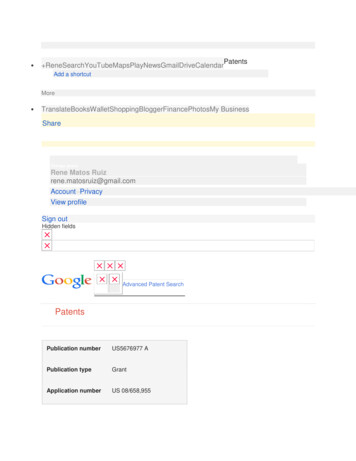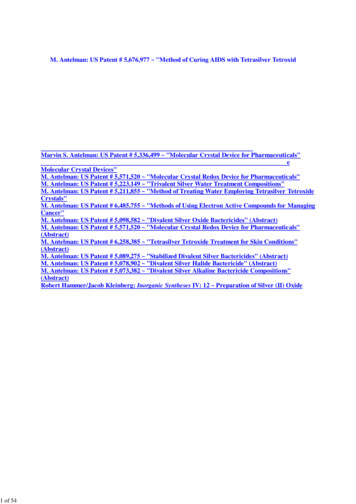
Transcription
1 of 54M. Antelman: US Patent # 5,676,977 "Method of Curing AIDS with Tetrasilver TetroxidMarvin S. Antelman: US Patent # 5,336,499 "Molecular Crystal Device for Pharmaceuticals"eMolecular Crystal Devices"M. Antelman: US Patent # 5,571,520 "Molecular Crystal Redox Device for Pharmaceuticals"M. Antelman: US Patent # 5,223,149 "Trivalent Silver Water Treatment Compositions"M. Antelman: US Patent # 5,211,855 "Method of Treating Water Employing Tetrasilver TetroxideCrystals"M. Antelman: US Patent # 6,485,755 "Methods of Using Electron Active Compounds for ManagingCancer"M. Antelman: US Patent # 5,098,582 "Divalent Silver Oxide Bactericides" (Abstract)M. Antelman: US Patent # 5,571,520 "Molecular Crystal Redox Device for Pharmaceuticals"(Abstract)M. Antelman: US Patent # 6,258,385 "Tetrasilver Tetroxide Treatment for Skin Conditions"(Abstract)M. Antelman: US Patent # 5,089,275 "Stabilized Divalent Silver Bactericides" (Abstract)M. Antelman: US Patent # 5,078,902 "Divalent Silver Halide Bactericide" (Abstract)M. Antelman: US Patent # 5,073,382 "Divalent Silver Alkaline Bactericide Compositions"(Abstract)Robert Hammer/Jacob Kleinberg: Inorganic Syntheses IV: 12 Preparation of Silver (II) Oxide
3 of 54US Patent # 5,336,499August 9, 1994 Cl. 424/618Molecular Crystal Device for PharmaceuticalsMarvin S. AntelmanAbstract A novel molecular scale device is described which is bactericidal, fungicidal, viricidal and algicidal. Theanti-pathogenic properties of the device are attributed to electron activity indigenous to diamagneticsemiconducting crystals of tetrasilver tetroxide ( Ag4O4 ) which contains two monovalent and twotrivalent silver ions in each molecular crystal. When the crystals are activated with an oxidizing agent, theyrelease electrons equivalent to 6.4 x 10-19 watts per molecule which in effect electrocute pathogens. Amultitude of these devices are effective at such low concentrations as 0.3 PPM used as preservatives in avariety of formulations ranging from cosmetics to pharmaceuticals. Indeed, they are intended as activeingredients for pharmaceuticals formulated to destroy such pathogens as Staphylococcus aureus, andepidermidis, the latter of which it completely destroys in a nutrient broth culture of about 1 millionorganisms at 0.6 PPM, or Candida albercans, the vaginal yeast infection at 2.5 PPM, and the AIDS virus at18 PPM.References Cited
4 of 54U.S. Patent Documents:4695353 Sep., 1987 Jansen, et al. 423/6044717562 Jan., 1988 Jansen, et al. 423/6044835077 May, 1989 Megahed et al. 423/6045017295 May, 1991 Antelman 424/6185073382 Dec., 1991 Antelman 424/6015078902 Jan., 1992 Antelman 424/6015089248 Feb., 1992 Akhtar 423/6045089275 Feb., 1992 Antelman 424/601Primary Examiner: Page; Thurman K. Assistant Examiner: Hulina; AmyAttorney, Agent or Firm: Salter & MichaelsonClaims What is claimed is:1. A method of inhibiting the growth of pathogens in pharmaceutical and cosmetic products, saidpathogens selected from the group consisting of E. coli, Micrococcus Luteus, Staphylococcus aureus,Staphylococcus epidermidis, Pseudomonas aeruginosa, Streptococcus pyogenes, Candida Albicans, andSaccharomycetpideae, which comprises introducing molecular semiconductor crystal devices of themolecule tetrasilver tetroxide ( Ag4O4 ) in the presence of an oxidizing agent comprising a persulfate.Description BACKGROUND OF THE INVENTIONThe present invention relates to the employment of molecular crystals as bactericidal, viricidal andalgicidal devices, but more particularly to the molecular semiconductor crystal tetrasilver tetroxideAg.sub.4 O.sub.4 which has two trivalent and two monovalent silver atoms per molecule, and whichthrough this structural configuration enables electronic activity on a molecular scale capable of killingalgae and bacteria via the same mechanism as macroscale electron generators. The concept of molecularscale semiconductor devices for the storage of information has been the subject of much activity in recentyears so that the concept of a molecular scale device performing such functions as storing information oracting as resistors, capacitors or photovoltaic devices is well accepted. The molecular device of thisinvention is a multivalent silver diamagnetic semiconductor. Now the bactericidal activity of solubledivalent silver (Ag II) complex bactericides is the subject of U.S. Pat. No. 5,017,285 of the presentinventor. The inventor has also been granted U.S. Pat. Nos. 5,078,902, USP # 5,073,382, USP # 5,089,275,and USP # 5,098,582, which all deal with Ag II bactericides but more particularly with (respectively)halides, alkaline pH, stabilized complexes and the divalent oxide. It is the last patent, i.e., U.S. Pat. No.5,098,582, and its perfection that has led to my original concept of the molecular device of the presentinvention. Now said patent designated AgO as divalent silver oxide, the popular name of the compound.Indeed, the Merck Index (11th Edition) designates the oxide as silver(II) oxide (AgO) (entry 8469).However, it also states that it is actually a silver(I)-silver(III) oxide with a molecular weight of 123.88.Said oxide is actually on a molecular level Ag4O4 where one pair of silver ions in the molecule is trivalentand another pair is monovalent.While the formula AgO accurately designates the silver:oxygen ratio, the molecular weight of thecompound is actually 495.52. Further elucidation of the molecule's electromagnetic properties reveals thatit is a diamagnetic semiconductor. The structure is electronically active because of the trivalent sp.sup.2electron configuration disparity of the electrons within the crystal.Further testing of the unique oxide was continued on various types of bacteria, molds, yeasts and algae,beyond the water treatment applications claimed in my previous patents. The phenomenal efficacy of saidoxide against pathogens while they were in constant contact with their nutrient source in contradistinctionto its efficacy with these same organisms in water, where the pathogen is separated from a constantnutrient source, could only be accounted for by considering each molecule of oxide as a "device". This inturn has led to the final development of this invention, namely, a molecular device for killing viruses,fungi, algae and bacteria, which can be utilized as the active component of pharmaceuticals and as apreservative against said pathogens in pharmaceutical and other products.OBJECTS OF THE INVENTION
5 of 54The main object of this invention is to provide for a molecular scale device of a single tetrasilver tetroxidesemiconductor crystal capable of killing viruses, bacteria, fungi and algae when operating in conjunctionwith other such devices.Another object of the invention is to provide for a molecular device which can be utilized inpharmaceuticals formulated to destroy pathogens.Still another object of the invention is as a preservative in pharmaceutical, cosmetic, and related chemicalspecialty products against said pathogens.Other objects and features of the present invention will become apparent to those skilled in the art whenthe present invention is considered in view of the accompanying examples. It should, of course, berecognized that the accompanying examples illustrate preferred embodiments of the present invention andare not intended as a means of defining the limits and scope of the present invention.SUMMARY OF THE INVENTIONThis invention relates to a molecular scale device capable of destroying gram positive and gram negativebacteria as well as fungi, viruses and algae. Said molecular scale device consists of a single crystal oftetrasilver tetroxide. Several hundred thousand trillion of these devices may be employed in concert fortheir bactericidal, fungicidal, and algicidal properties and applied to industrial cooling towers, swimmingpools, hot tubs, municipal water supplies and various pharmaceutical formulations.The molecular crystals which are the subject of this invention are commercially available and can beprepared by reacting silver nitrate with sodium or potassium peroxydisulfate according to the followingequation: 4AgNO3 2Na2S2O8 8NaOH Ag4O4 4Na2SO4 4NaNO3 4H2O The oxide latticerepresented by the formula Ag4O4 is depicted in the Drawing FIG. 1. It is a semiconducting electron activediamagnetic crystal containing two monovalent and two trivalent silver ions in combination with fouroxygen atoms. The distance between the Ag(III)-O Ag(I)O units equals 2.1 A. Ag(III)-Ag(III) Ag(I)-Ag(I) 3.28A and Ag(I)-Ag(III) 3.39 A. Each trivalent silver ion is coordinated via dsp2 electronbonds to 4 oxygen atoms. The depiction of this lattice is based on several literature references relating tocrystallographic studies. Exemplary of this literature are J. A. McMillan's studies appearing in InorganicChemistry 13,28 (1960); Nature vol. 195 No. 4841 (1962), and Chemical Reviews 1962, 62, 65. Alvin J.Salkind elucidated studies involving neutron diffraction with his coworkers (J. Ricerca Sci. 30, 1034 1960)proving the Ag(III)/Ag(I) nature of this molecule and states in his classic entitled Alkaline StorageBatteries (Wiley 1969), coauthored with S. Uno Falk, that the formula is depicted by Ag4O4 (page 156).That same year a scientific communication appeared in Inorganic Nuclear Chemistry Letters (5,337)authored by J. Servian and H. Buenafama which maintained that their neutron diffraction studies alsoconfirmed the tetroxide lattice and the presence of Ag(III) and Ag(I) bonds in the lattice, a conclusion alsoreported previously by Naray-Szahn and Argay as a result of their x-ray diffraction studies (Acta Cryst.1965, 19,180). Thus the effects of this invention can be explained in terms of these structural elucidations,namely, that the single molecular semiconductor crystal which inevitably must be electronically activeexchanging two electrons per crystals between its mono and trivalent bonds is in reality a device whichkills pathogens in the same manner as electrically active large-scale devices utilized in water supplies.When the tetroxide crystals are utilized to destroy pathogens, they will not do so unless activated by anoxidizing agent. This is analogous to the behavior of single semiconducting photovoltaic molecular devicessuch as copper indium selenide whose surfaces must be "etched" in order to activate the photovoltaicactivity, i.e., for light to facilitate the release of electrons from the molecule. The tetroxide was activatedby persulfates. It was found that when the persulfates were tested as a control by themselves, they failedto exhibit any unilateral antipathogenic activity at the optimum level selected of 10 PPM. The persulfatesevaluated varied from Oxone (Registered Trademark Du Pont Company) brand potassium monopersulfateto alkali peroxydisulfates.DESCRIPTION OF THE DRAWINGIn the drawing which illustrates the best mode presently contemplated for carrying out the presentinvention:FIG. 1 is a diagrammatic view showing the crystal lattice of Ag4O4attacking a pathogenic bacillus.
6 of 54DESCRIPTION OF THE INVENTIONTurning now to Drawing FIG. 1 depicting the crystal lattice of Ag4O4, the device operates by transferringelectrons from the monovalent silver ions 10 to the trivalent silver ions 11 in the crystal 20 through theaqueous media in which it is immersed and which conducts electrons depicted by the path 12, contributingto the death of pathogen 13 with electrons 14, traversing the cell membrane surface 15, said pathogenbeing "electrocuted" by not only these electrons but by others: 16 and 17 following paths 18, and 19emanating from other molecular devices in the vicinity of the pathogen. The device is attracted to the cellmembrane surface 15 by powerful covalent bonding forces 21 caused by the well-known affinity of silverto certain elements present in the membrane, such as sulfur and nitrogen. Drawing FIG. 1 exaggerates thesize of the silver oxide molecular device with respect to that of a microorganism for depiction purposesonly.The electron transfer can be depicted by the following half reactions in which the monovalent silver ionloses an electron and the trivalent silver gains one as follows:Ag -e Ag 2Ag 3 e Ag 2The molecular crystal then will become stabilized with each silver ion having a divalent charge.Stringent testing was performed in which cultures were actually placed in trypticase soy nutrient broth,which allowed the pathogens being tested to replicate without being detached from its own food supply.Under these conditions the devices were able to kill two strains of E. Coli at 2.5 PPM; MicrococcusLuteus at 1.25 PPM; Staphylococcus aureus at 2.5 PPM; Staphylococcus epidermidis at 0.6 PPM;Pseudomonas aeruginosa at 1.25 PPM; and Streptococcus pyogenes at 2.5 PPM.The devices were then evaluated in analogous nutrient used for yeasts, algae and molds utilizingSabouraud dextrose broth. The infectious yeast pathogen Candida ALBICANS was totally killed at 2.5PPM and that of the Saccharomycetpideae variety at 1.25 PPM.
7 of 54If we are to consider one molecular device in operation, then each molecule would release two electronshaving each a charge of 4.8 x 10-10 e.s.u. equivalent to approximately 1.6 x 10-19 coulombs. The EMFgiven in my Encyclopedia of Chemical Electrode Potentials (Plenum 1982), page 88, for the oxidation ofAg(I) to Ag(II) is 1.98 volts which approximates 2.0 V. The total power output per device can becalculated in watts by multiplying the power output for each electron by 2. Since power is the product ofthe potential times the charge, P EI; for each electron it would be2.0 x 1.6 x 10-19 3.2 x 10-19 wattsFrom this, and using Avogadro's number, we can calculate that the power flux of one liter of solutioncontaining 0.5 PPM of devices would be 0.064 watts. Since the electronic charges of the devices aredirectly proportional to the number of devices in s
M. Antelman: US Patent # 5,676,977 "Method of Curing AIDS with Tetrasilver Tetroxid e Molecular Crystal Devices" M. Antelman: US Patent # 5,571,520 "Molecular
